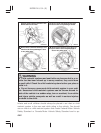
IMPREZA U.S.A. (E)
2-28
*SRS AIRBAG
(Supplemental Restraint System Airbag)
*SRS: This stands for supplemental restraint system. This name is used
because the AIRBAG system supplements the vehicle’s seat belts.
J Vehicle with driver’s and front passenger’s SRS AIRBAGs and
lap/shoulder restraints
WARNING
D To obtain maximum protection in the event of an accident, the
driver and all passengers in the vehicle should always wear seat
belts when the vehicle is moving. The SRS AIRBAG does not do
away with the need to fasten seat belts. In combination with the
seat belts, it offers the best combined protection in case of a seri-
ous accident.
Not wearing a seat belt increases the chance of severe injury or
death in a crash even when the car has the SRS AIRBAG.
For instructions and precautions concerning the seat belt sys-
tem, see the sections 3-point Type Seat Belts and 2-point Type
Seat Belts in this chapter.
D Do not sit or lean unnecessarily close to the SRS AIRBAG. The
SRS AIRBAG deploys with considerable speed – faster than the
blink of an eye – and force to protect in high speed collisions.
However, the force of an SRS AIRBAG can injure an occupant
whose body is too close to SRS AIRBAG. It is also important to
wear your seat belt to help avoid injuries that can result when the
SRS AIRBAG contacts an occupant not in proper position such
as one thrown toward the front of the car during pre-accident
braking.
D The SRS AIRBAGs deploy with considerable speed and force.
Occupants who are out of proper position when the SRS AIRBAG
deploys could suffer very serious injuries. Because the SRS AIR-
BAG needs enough space for deployment, the driver should al-
ways sit upright and well back in the seat as far from the steering
wheel as practical while still maintaining full vehicle control and


















